Attached is a Regional Order No. 2 from Malcolm S. Garma, Regional Director, DepEd Region I, dated April 11, 2019, entitled “POLICY GUIDELINES ON THE UTILIZATION OF SCHOOL-BASED MANAGEMENT (SBM) ASSESSMENT TOOL WITH CONTEXTUALIZED MEANS OF VERIFICATIONS (MOVs)” which is self-explanatory, for the information of all concerned.
Table of Contents
POLICY GUIDELINES ON THE UTILIZATION OF SCHOOL-BASED MANAGEMENT (SBM) ASSESSMENT TOOL WITH CONTEXTUALIZED MEANS OF VERIFICATIONS (MOVs)
- The Department of Education-Regional Office 1 issues the enclosed Policies and Guidelines on the Utilization of School-Based Management Assessment Tool with contextualized Means of Verifications to all public elementary and secondary schools within the region.
- This Policy and its implementing guidelines shall be effective immediately upon issuance and shall remain in force and in effect until revoked.
- All Regional Orders/Memoranda, and other related issuances, provisions, rules and regulations, which are inconsistent with these guidelines are hereby replaced, repealed, or amended accordingly.
- Immediate dissemination and strict compliance with these guidelines is directed.
IMPLEMENTING GUIDELINES ON THE UTILIZATION OF SCHOOL-BASED MANAGEMENT (SBM) ASSESSMENT TOOL WITH CONTEXTUALIZED MEANS OF VERIFICATIONS (MOVs)
I. GENERAL PROVISIONS
Section 1. Statement of Policy
Article II, Section 17 of the 1987 Constitution of the Republic of the Philippine states that “The state shall give priority to education, science and technology, arts, culture, and sports to foster patriotism and nationalism, accelerate social progress, and promote total human liberation and development.” Article XIV, Section 1 also states that “The State shall protect and promote the right of all citizens to quality education at all levels and shall take appropriate steps to make such education accessible to all.”
The implementation of the Governance of Basic Education Act of 2001 (RA 9155) provides the mandate for decentralizing the system of school management anti recognizes the role of the Local Government Units and other stakeholders as partners in education service delivery. Consequently, the Department of Education launched the Schools First Initiative (SFI) in 2015 to empower the school and its community stakeholders to effectively address access and quality issues in basic education. To be able to deliver to the Filipino people the quality education they need, Republic Act 9155 or the Governance of Basic Education Act of 2001 was signed and enacted into law Section 2 of RA 9155 states that the policy and principle for the governance of basic education shall be translated into programs, projects and services developed, adapted and offered to fit local needs.
Pursuant to the above mandate, the Department of Education issued DepEd Order No. 83, s. 2012 to further strengthen the School-Based Management (SBM) practice and re-emphasize the centrality of the learners and the involvement of relevant community basic education service delivery.
With the implementation of the Rationalization Plan that took place last 2015, in compliance to DepEd Order No. 52 s. 2015, the Field Technical Assistance Division (FTAD) was created to facilitate the delivery of quality basic education and create an enabling environment for schools and learning centers. Moreover, Field Technical Assistance Division (FTAD) is also mandated to lead, coordinate and integrate the provision of technical assistance to Schools Division Offices. For that, Field Technical Assistance Division (FTAD) was assigned to lead the monitoring and assessment of the School-Based Management level of practice to all Schools Division Offices with the support and assistance of the reorganized Regional Field Technical Assistance Teams (RFTATs).
Hence, this Regional Policy and its implementing guidelines shall be effective immediately upon issuance. The Schools Division Offices and School administrators shall adhere to this Regional Policy to harmonize and unify the SBM assessment in both public elementary and secondary schools. In fact, both transcending framework and happy schools advocacy of the Region aim to level up the SBM level of practice of all schools.
To fully achieve the purpose, a School-Based Management (SBM) assessment tool was crafted with contextualized Means of Verifications (MOVs). This tool is in consonance to DepED Order No. 83 s. 2012. The School-Based Management Assessment Tool is guided by the four principles of ACCESs (A Child (Learner) -and Community-Centered Education Systems). These are:
- Principle of Collective leadership and Governance
- Principle of Community-Based learning
- Principle of Accountability for Performance and results
- Principle of convergence to Harness Resources for education
ACCESs is both a product and process. As a product, it is the ultimate outcome of the communities/barangays working together to protect the right of every child for quality education and better life. As a process, it is an approach to effectively decentralize and bring to reality the mainstreaming of education as a tool for human development and total community transformation.
In any case, the SBM practice is ascertained by thev existence of structured mechanisms, processes, and practices in all indicators. A team of practitioners and experts from the district, division, region and central office validates the self-study/assessment before a level of SBM is established. The purpose of selfassessment is to determine the school’s level of SBM practice. An SBM assessment tool is used to gather data, which are analyzed for evidence using the DOD (Documentary Analysis, Observation, Discussion) process. DOD is an acronym of Document Analysis, Observation, and Discussion-three essential steps in evaluating the validly of an evidence of an SBM practice. Below are the steps:
- Conduct Document Analysis (using artifacts)
- Conduct observations to obtain process evidence (individual or group interviews)
- Discuss the synthesized documentary and process evidence, (consensual decision)
To further check the level of implementation of SBM in the region, the Department of Education Regional Office I, through the Field Technical Assistance Division (FTAD), contextualized the Means of Verifications/artifacts in each criterion of the SBM Assessment tool.
In fact, the contextualized Means of Verifications (MOVs)/artifacts of the tool was based on the collective efforts of both the region and divisions. A Focal Group Discussion (FGD) was conducted between and among the FTAD, QAD representative, SBM Coordinators, SGOD Chiefs, and selected school administrators to gather inputs, insights and appropriate Means of Verifications (MOVs)/artifacts of the schools.
Furthermore, FTAD endorsed the assessment tool to all the Regional Division Chiefs to further check and integrate other inputs/MOVs/artifacts. Finally, the contextualized Means of Verifications (MOVs)/artifacts of the SBM assessment tool was submitted to Quality Assurance Division (QAD) to quality assure and integrate the inclusion of the Document Analysis, Observation, Discussion (DOD) process to the tool prior the approval of Assistant Regional Director and Regional Director.
Related researches are in support to the SBM Assessment Tool like that of Datu1 (2016) who states that SBM generate public confidence. She also states that the wide knowledge and skills of administrators, perseverance of teachers and pupils, cooperation of parents and community coupled with strong networking and linkages are ingredients to a successful SBM program. This also affirms the study of Bucud (2016), which states that community participation plays a vital role in the implementation of SBM.
The SBM Assessment Tool aims to determine the SBM level of the schools of the fourteen (14) schools division offices which shall be used by the following:
a. School Heads- for self-assessment on the SBM level of practice.
b. SDO SBM Monitoring Teams – for monitoring the schools on the implementation of SBM.
c. Regional Field Technical Assistance Teams (RFTATs)- for validating the SBM level of practice of the schools.
With the reorganization of the SBM Task Forces, the Regional Office and Schools Division Offices are hereby directed to reorganize the SBM Task Forces. The teams shall now be called the Regional SBM Coordinating Teams/Regional Field Technical Assistance Teams (RFTATs) and Division SBM Coordinating Team/Division Field Technical Assistance Teams (DFTAT).
Section 2. References
- 1987 Philippine Constitution
- Republic Act 9155 of 2001
- DepEd Order No. 83 s. 2012
Section 3. Definition of Terms
ACRONYM
SBM – School-Based Management
ACCESS – (A Child (Learner) – and Community-Centered Education Systems)
BHROD – Bureau of Human Resource and Organizational Development SED- School Effectiveness Division
RFTATs – Regional Field Technical Assistance Teams
DFTATs – Division Field Technical Assistance Teams
MOVs – Means of Verifications
CIGPs – Concerns, Issues, Gaps and Proposed solutions.
MOA – Memorandum of Agreement.
MOU – Memorandum of Understanding.
MOOE – Maintenance and Other Operating Expenses.
BAC – Bids and Awards Committee
WinS -Water, Sanitation, and Hygiene in Schools.
DOD – Document Analysis, Observation, Discussion.
- is an exciting growth experience. Analysis of documents, artifacts, and processes unfold the progress made, objectives achieved, new techniques developed, best practices mainstreamed, prices won-despite limited resources and physical, social and political constraints.
Advanced (Accredited Level) – School-Based Management level of practice -level 3.
- Ensuring the production of intended outputs I outcomes and meeting all standards of a system fully integrated in the local community and is self-renewing and self-sustaining. Assessment – refers to the wide variety of methods or tools that educators use To evaluate, measure, and document the academic readiness, learning progress, skill acquisition, or educational needs of students.
Artifacts – are things used by the school community to achieve educational goals, e.g. Daily Lesson Log (DLL), ESIP. v
Contextualize – refers to the educational process of relating the curriculum to a particular setting, situation or area of application to make the competencies relevant, meaningful and useful to the learners.
Developing – School-Based Management level of practice – level 1.
- Developing structures and mechanisms with acceptable level and extent of community participation and impact on the learning outcomes. Genderized Comfort room -is a public toilet that all people, regardless of gender identity or expression, can use.
Indigenize – to adapt (beliefs, customs, etc.) to local ways.
Indigenous Education – specifically focuses on teaching indigenous knowledge, models, methods, and content within formal or non-formal educational systems.
Maturing – School-Based Management level of practice – level 2.
- Introducing and sustaining continuous improvement process that integrates wider community participation and improve significantly performance and learning outcomes.
Stakeholder – refers to anyone who is invested in the welfare and success of a school and its students, including administrators, teachers, staff members, students, parents, families, community members, local business leaders, and elected officials such as school board members, city councilors, and state representatives.
- may also be collective entities, such as local businesses, organizations, advocacy groups, committees, media outlets, and cultural institutions, in addition to organizations that represent specific groups, such as teachers unions, parent-teacher organizations, and associations representing superintendents, principals, school boards, or teachers in specific academic disciplines.
Transcending school – school goes beyond the limits, overstep or surpass the highest SBM level of practice leading to a happy, quality, accessible, relevant and liberating education.
II. GUIDELINES
Section 4. Rules and Regulations
A. Guides and Instructions
The School Heads/DFTATs/RFTATs shall strictly adhere to the prescribed guides and scoring instructions in the SBM Assessment Tool for the SBM Level of Practice.
1) The four (4) principles were assigned percentage weights on the basis of their relative importance to the aim of school (improved learning outcomes and school operations);
| Leadership and Governance | 30% |
| Curriculum and Learning | 30% |
| Accountability and Continuous Improvement | 25% |
| Management of Resources | 15% |
2) Each principle has several indicators. Based on the results of the D-O-D (Document Analysis, Observation, Discussion), summarize the evidences, and arrive at a consensus on the rating that will be given to each indicator;
3) Rate the items by ticking the appropriate circles. These are the points earned by the school for the specific criteria. The rating scale is:
0 – No Means of Verifications (MOVs)
SBM Level 1 – MOVs indicate early or preliminary stages of implementation.
SBM Level 2 – MOVs indicate planned practices and procedures are fully Implemented.
SBM Level 3 – MOVs indicate practices and procedure satisfy quality Standards.
4) Count the number of check marks in each criterion and record in the appropriate circle in the summary table (sub-total) for the area/standard rated;
5) Multiply the number of check marks in each column by the points (1-3);
6) Get the average rating for the principle by dividing the total score by the number of indicators of the principle;
7) Record the average ratings for the principle in the Summary Table for the computation of the General Average;
8) Multiply the rating for each principle by its percentage weight to get the weighted average rating;
Sample Computation:
Compute the scores by principle following the formula below: Total Score/Points x weighted percentage allotted to each principle No. of Indicators
Principle 1: Leadership and Governance
Total Score: 9
No. of Indicators: 5
Weighted Percentage 30%
9/5 x .30 =.54 points earned for Leadership and Governance
9) To get the total rating for the four principles, get the sum of all weighted ratings. The value derived is the school rating based on DOD;
10) The level of practice will be computed based on the criteria below:
60% based on improvement of learning outcomes
(in the absence NAT disregard the 60%)
40% according to the validated practices using the MOVs & DOD
11) The final scoring criteria as described in item 10 will be used after the operational try out.
12) All schools shall conduct self-assessment to be strictly checked and monitored by the DFTATs/Division Coordinating Team.
13) The DFTATs/Division Coordinating Team shall strictly monitor the selfassessment of all public elementary and secondary schools ready for the RFTATs’ and Central Office validation.
14) The RFTATs/Regional SBM Coordinating Team shall strictly check and validate the assessment of the DFTATs. In the absence of the SBM PASBE, all schools assessed as LEVEL III after the thorough validation will receive Certificate of Recognition from the Regional Office led by the Field Technical Assistance Division.
15) The Central Office -BHROD-School Effectiveness Division (SED) may monitor and assess the SBM level of practice of any schools in the region, which is in consistent with the mandate of School Effectiveness Division for Central Office policy enhancement or creation of new policy along SBM.
B. Description of SBM Levels of Practice
LEVEL I: DEVELOPING – Developing structures and mechanisms with acceptable level and extent of community participation and impact on the learning outcomes.
LEVEL II: MATURING – Introducing and sustaining continuous improvement process that integrates wider community participation and improve significantly performance and learning outcomes.
LEVEL III: ADVANCED (ACCREDITED LEVEL) – Ensuring the production of intended outputs/outcomes and meeting all standards of a system fully integrated in the local community and is self-renewing and self-sustaining.
III. Miscellaneous Provisions
Section 5. Separability Clause
Any part or provision of this Regional Memorandum which may be held invalid or unconstitutional shall not affect the validity and effectivity of other provisions.
Section 6. Repealing Clause
All prior Regional Orders/Memoranda or other issuances, or provisions thereof, which are inconsistent, are hereby repealed, revised, or modified accordingly.
Section 7. Effectivity
This Regional Memorandum shall take effect immediately upon issuance.
SCHOOL-BASED MANAGEMENT ASSESSMENT TOOL (DepED Order NO. 83 s. 2012) with CONTEXTUALIZED MEANS OF VERIFICATIONS (MOVs)
Objective:
This tool aims to determine the SBM level of practice of the schools of the fourteen (14) schools division offices which shall be used by the following:
a. School Heads – for self-assessment on the SBM level of practice.
b. SDO SBM Monitoring Team – for monitoring the schools on the implementation of SBM.
c. Regional Field Technical Assistance Team – for validating the SBM level of practice of the schools.
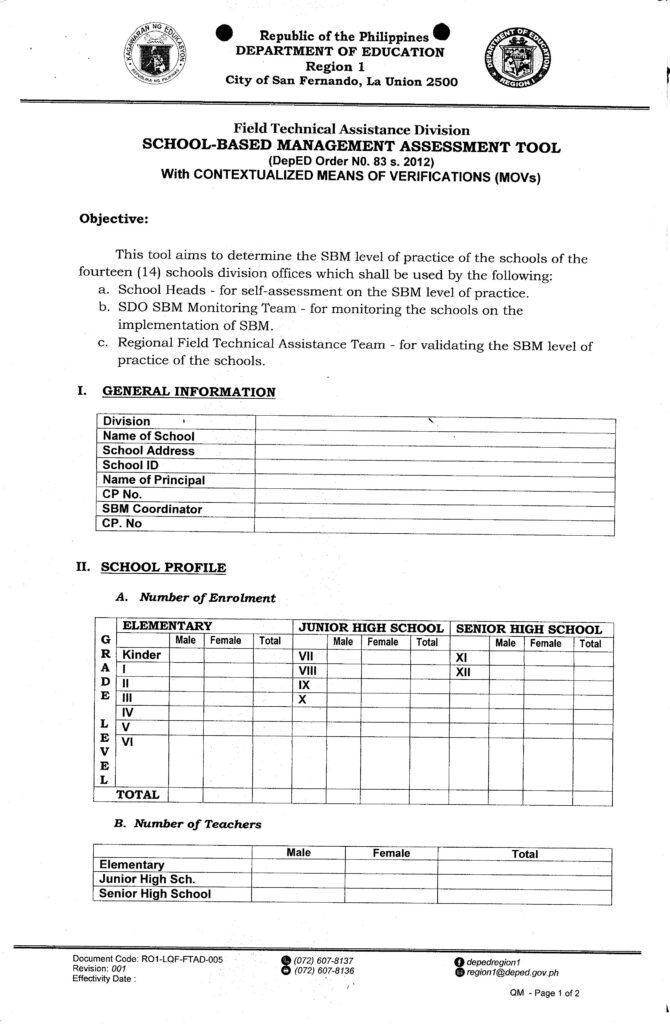
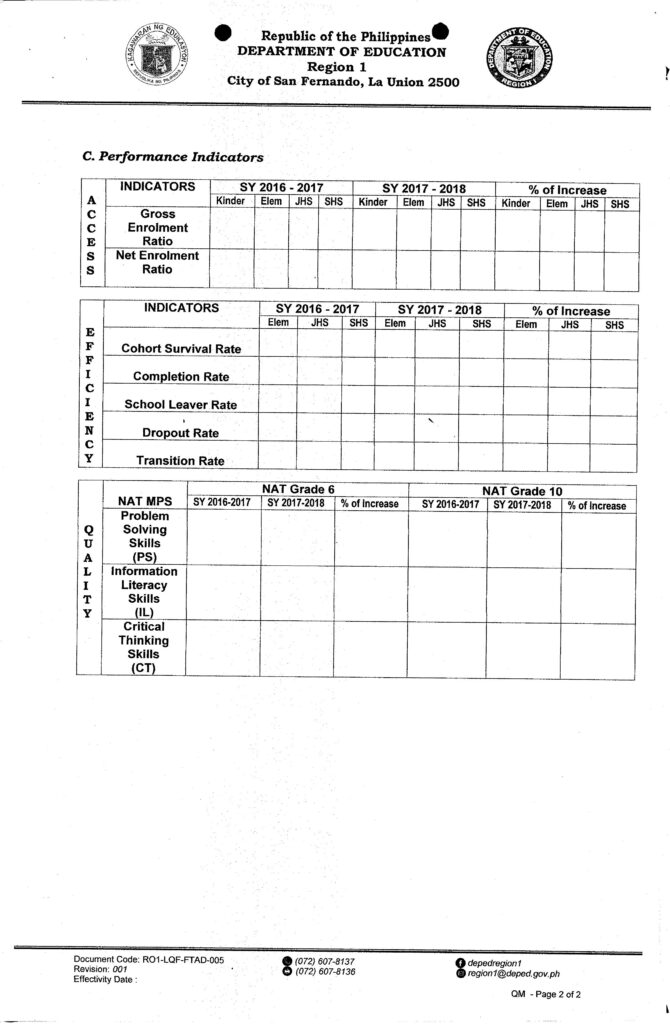
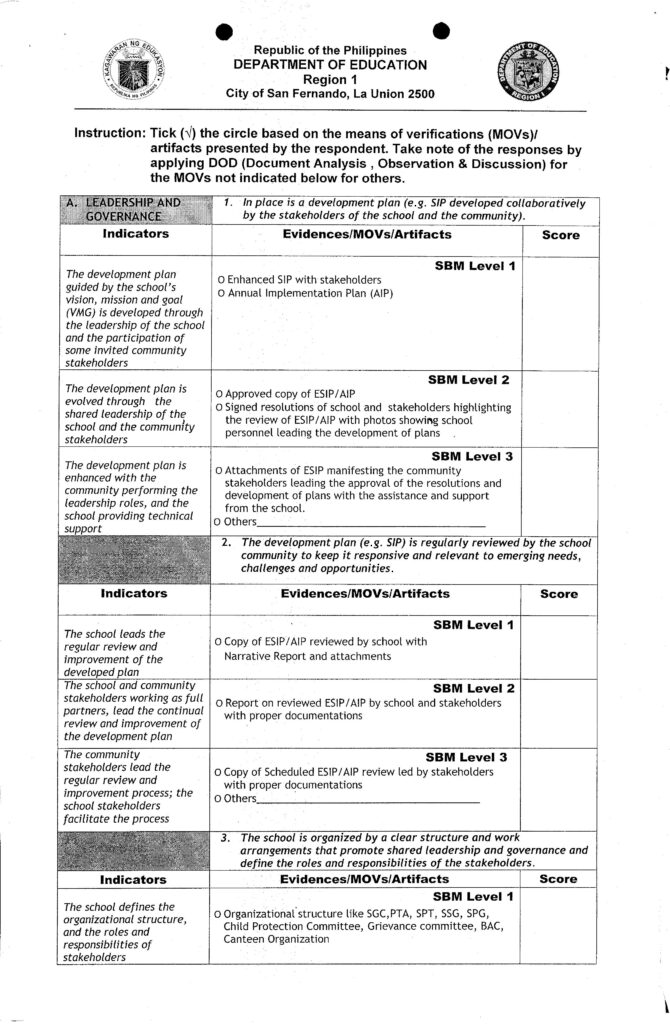
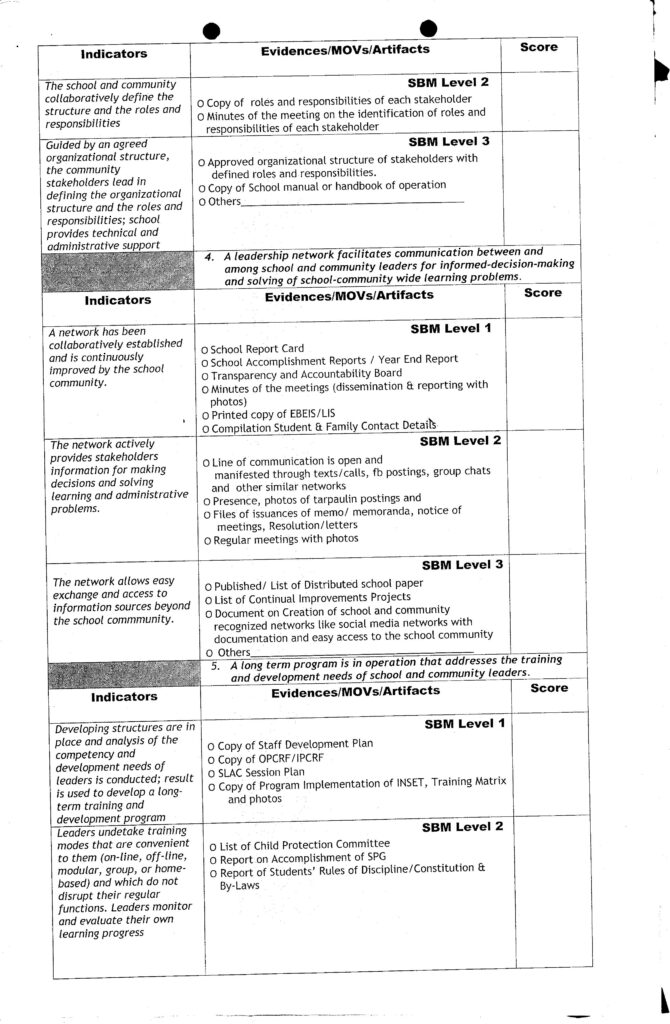
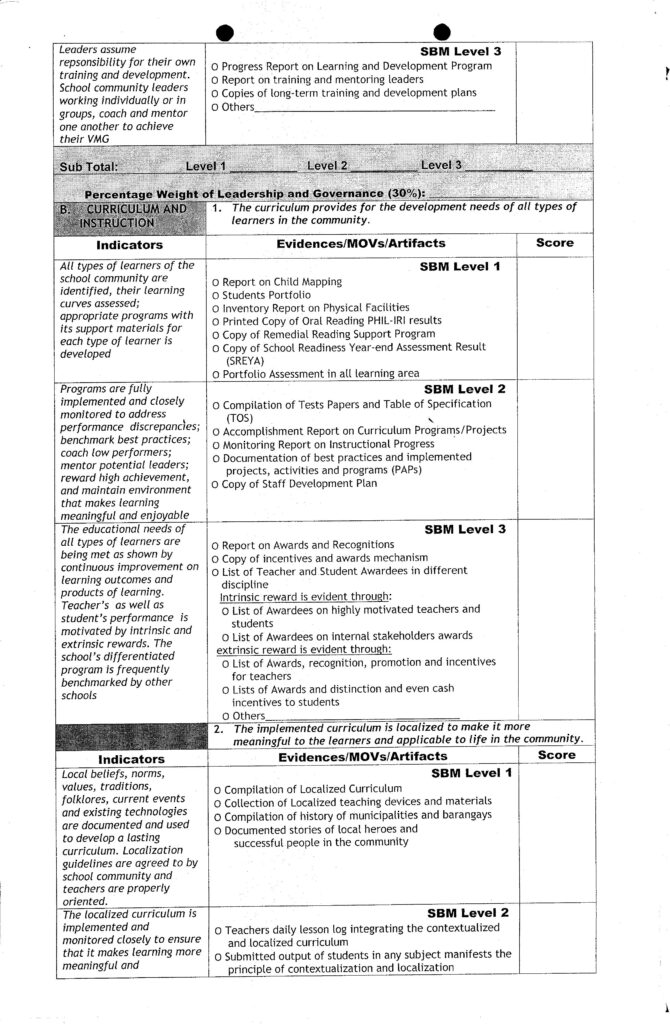
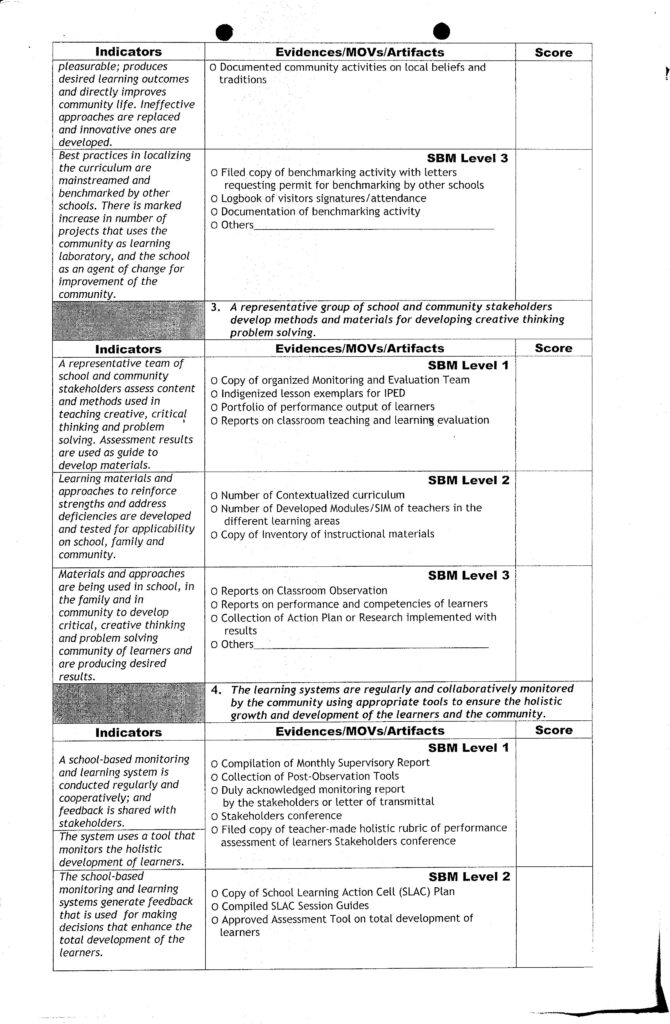
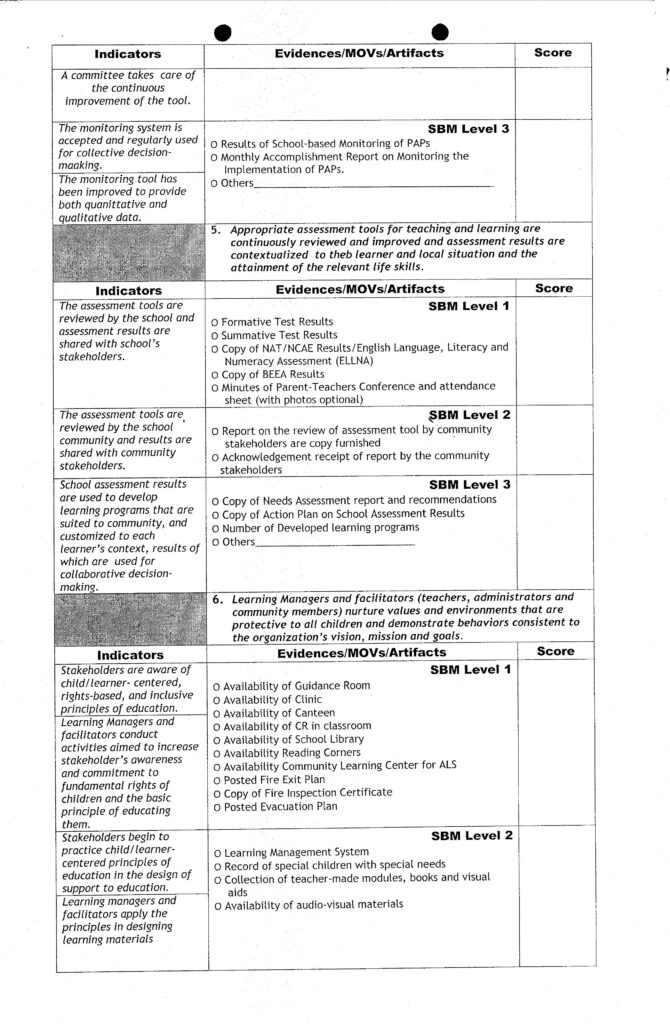
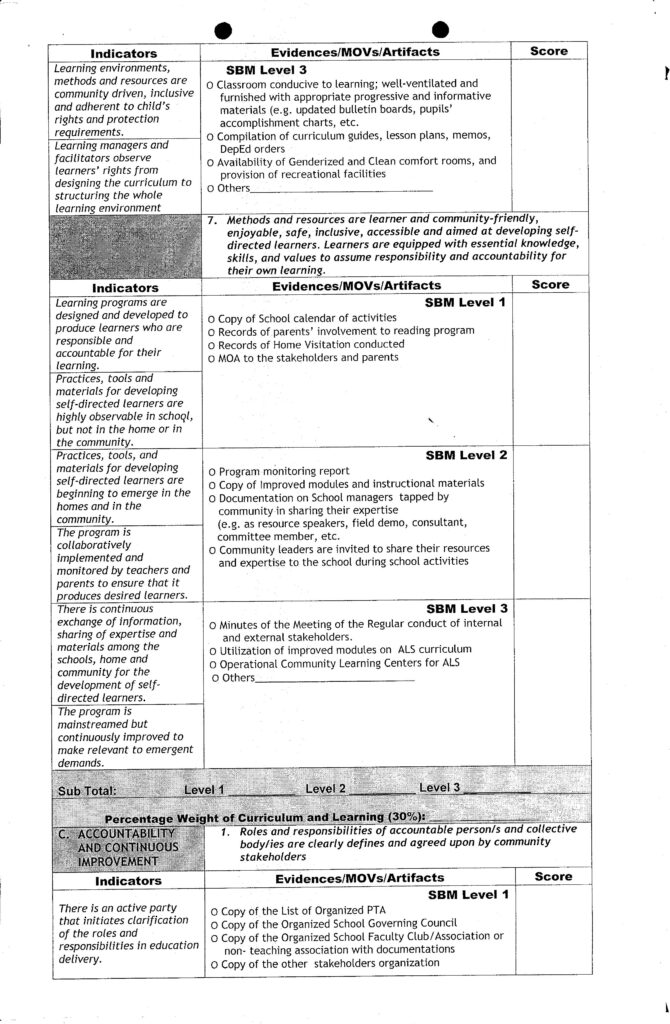
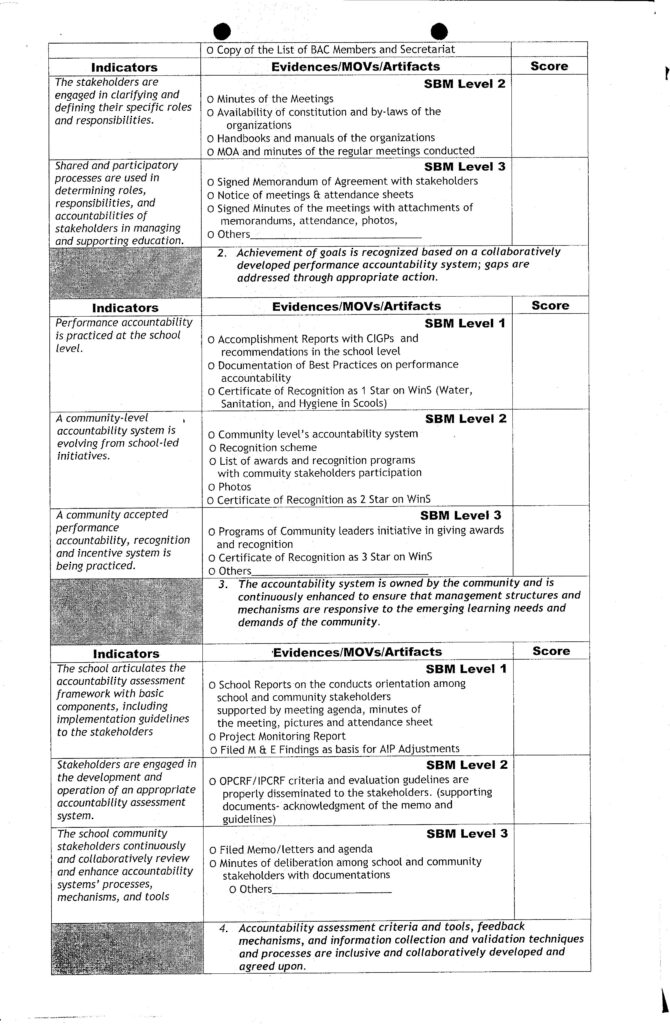
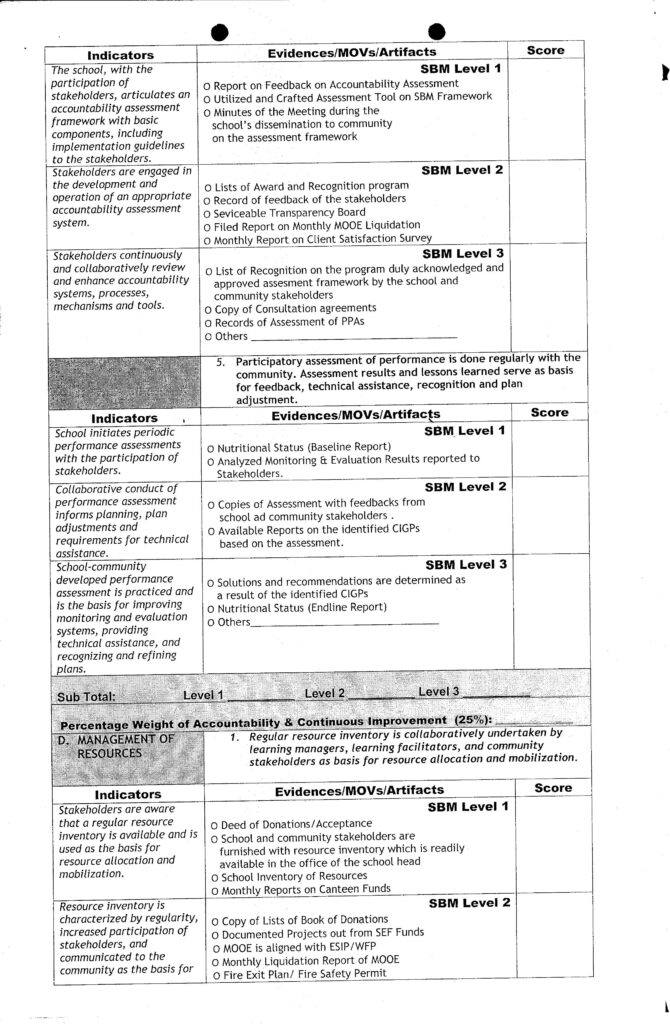
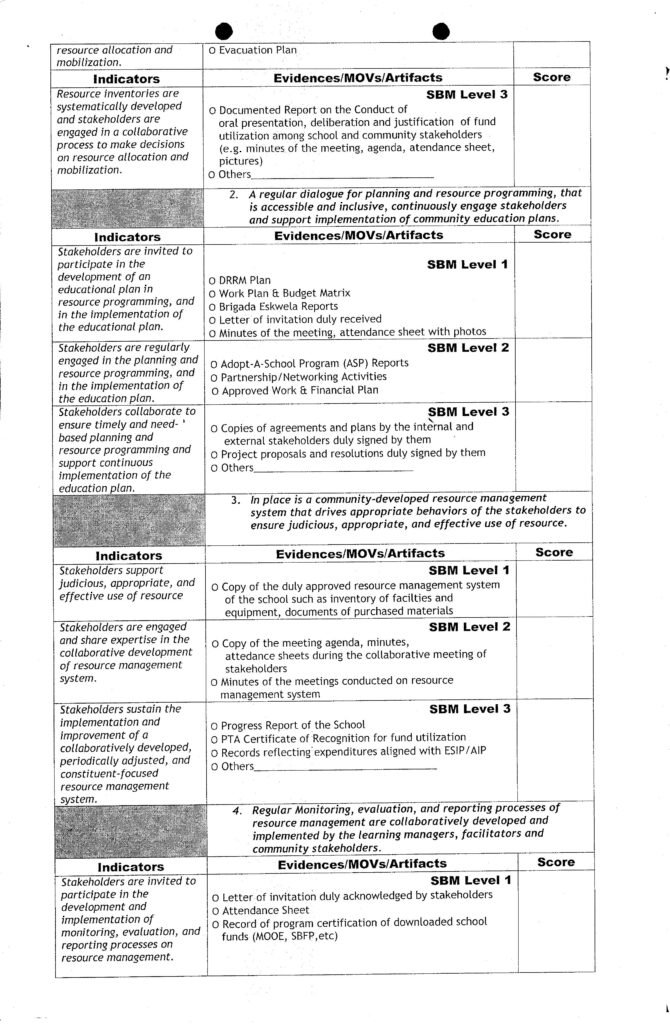
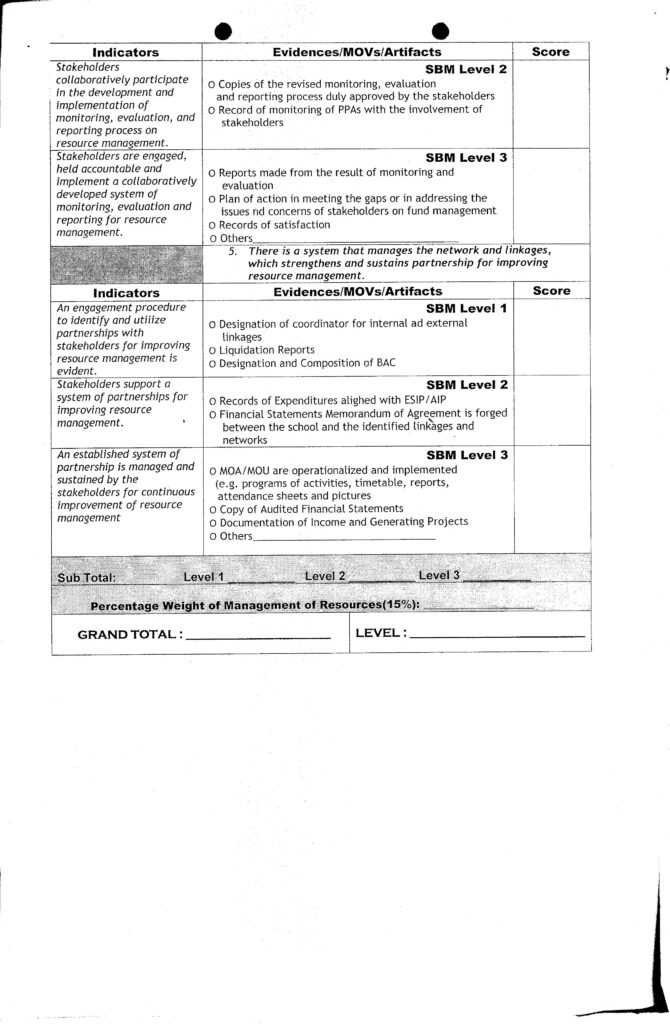
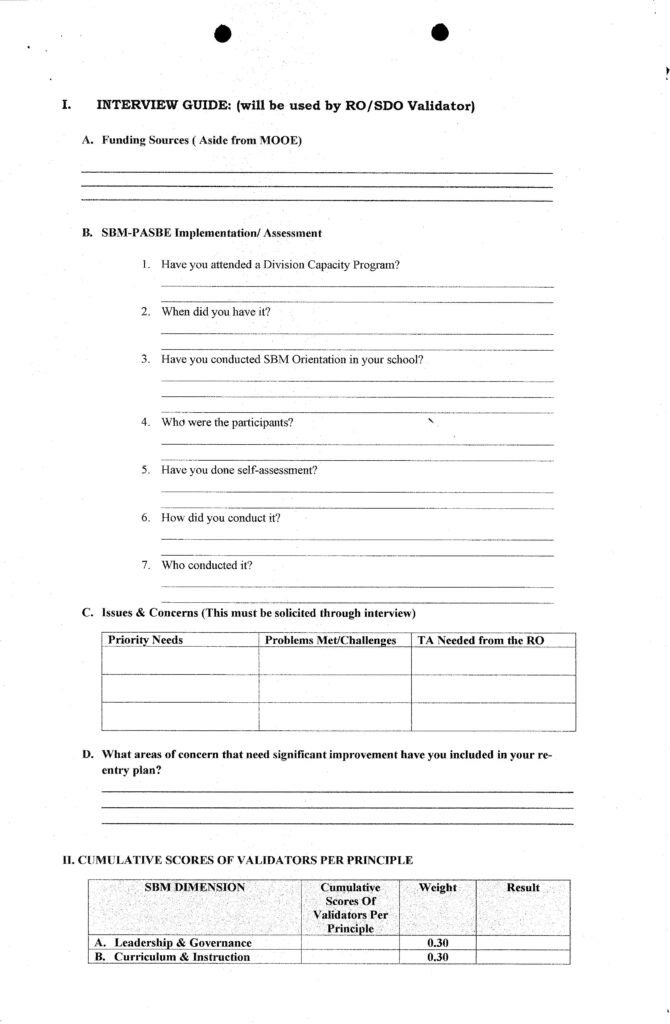
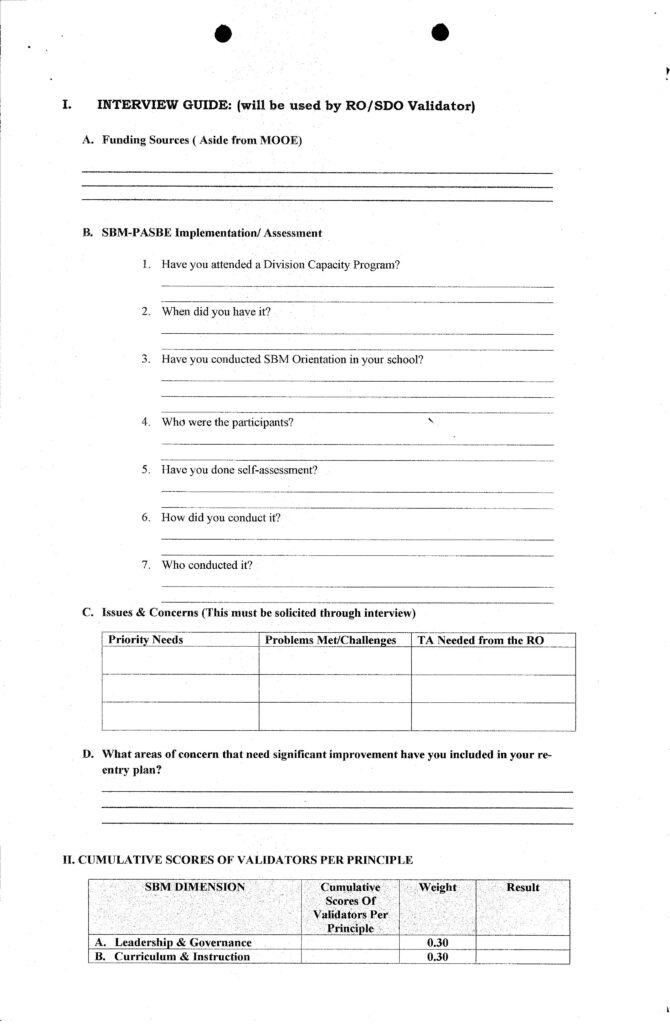
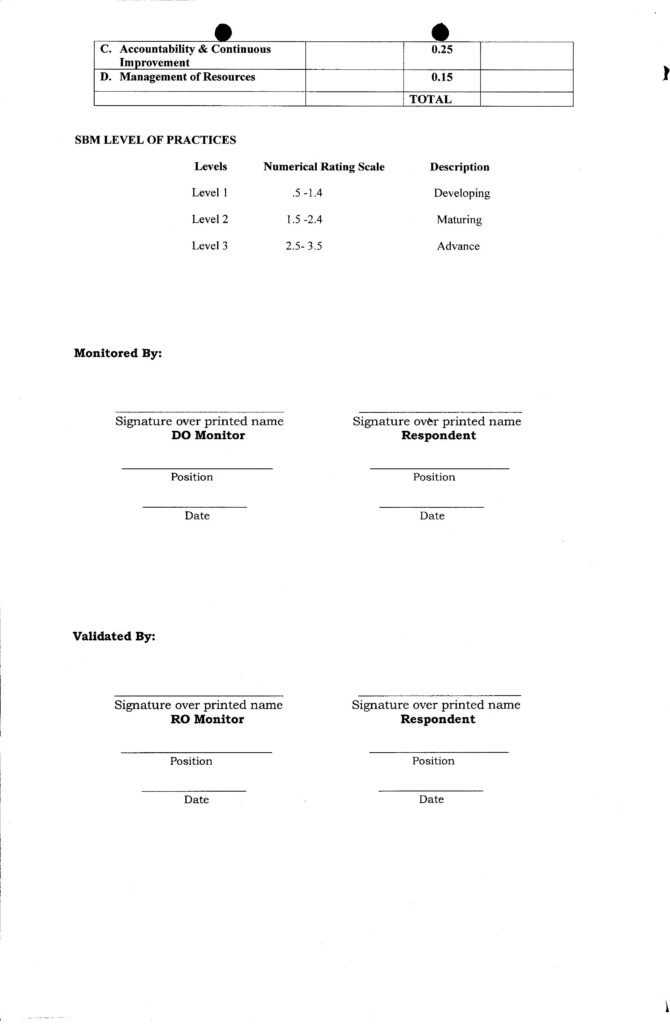
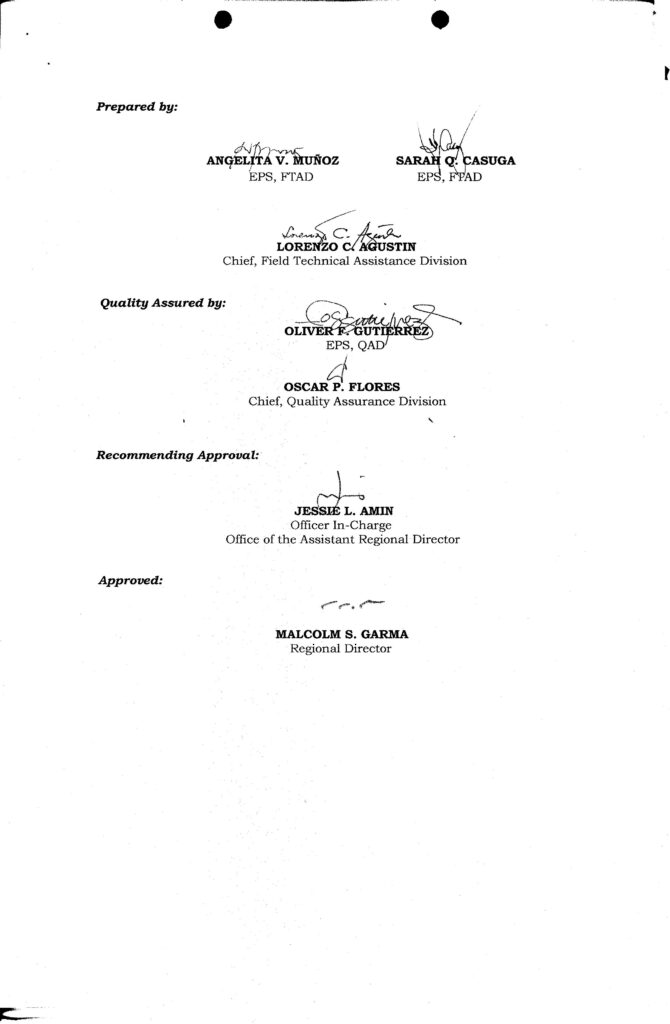
sir kindly send me a copy of SBM localized and SBM tool. Thank you and God bless!
can I have a copy sir? cetiejambo@gmail.com
Good day sir..
I would like to ask permission to adopt your localized materials in SBM tools. Kindly send me a copy of your SBM tool with contextualized MOVs.
Thank you very much….
Good day sir kindly send me a soft copy of SBM memo and SBM tool. Thank you in and God bless us.
What details should be filled in on the Technical Assistance Feedback Form?
Sir,
Kindly send me a copy of the memo.
The tools and MOV’s
Thank you so much
Felicitacion L.
Lopez
Good day sir, can you send me a copy of This memo, with SBM tool and MOV’s .
Thank you sir.
Dear Sir Llego,
Sir can you please send me a copy of SBM memo and SBM tool for my action research proposal ?
Thank you very much and more power.
Mam did you received a copy of sbm tool, can I also get a copy of that for my research.
Thanks
*receive
*receive
Sir good evening po puwede makahingi ng soft copy?
Good day po. Puwede pong makikihingi ng inyong conceptualized SBM tool MOV. ty po
Pls sent us also the contextualize movs for the sbm…most particularly in the principle 3
Not the movs it self but ur tools rather and sample plsease
Goodeve po.. If possible can we have a soft copy of this SBM memo and SBM Tool with contextualized MOVs…
Thank You,..
Good evening po, can I ask for the softcopy of SBM memo and SBM tool with contextualized MOVs din po? Salamat po..
carla.amabiles@deped.gov.ph
here’s my email address po, thank you,
Good day, I would like to ask permission to adopt your localized materials in SBM tools. Can i get the copy of SBM and memo tool? Thank you and Godbless.
Yours truly,
Teacher Camille
Please send me a copy of contextualized MOV
Please send me a copy of sbm tool on contextualized MOV po,thanks po
Hi..can you please share your expertise in SBM..we’re on level 3….Thank you..God bless
Good day po. Makikihingi naman po ng inyong conceptualized SBM tool MOV. ty po
Good day po. Kindly send me a copy of SBM tool with contextualized MOVs.. alicia.ortega001@deped.gov.ph
Sir kindly send me a copy of SBM tool with contextualize MOVs, thank you po.
sandra.cernio2@deped.gov.ph
Dear Sir Llego,
Please send me a copy of SBM Tool.
Thank you in advance.
Very truly yours,
Viol
Kindly send me a copy of SBM memo and SBM tool.
Thank you very much.
Good day, I would like to ask permission to adopt your localized materials in SBM tools. Thank you and more power!
Kindly send me a copy Of SBM tool. Email to anita.gadil001@deped.gov.ph.
Thank you very much.
Kindly send me a copy Of SBM tool. Email to carol.laconsay001@deped.gov.ph.
Thank you very much.
Dear Doc Llego,
Good day…
Kindly send me a copy of your SBM tool with contextualized MOVs.
Thank you.
God bless
Teacher Elvira
Dear Sir Llego,
I am presently conducting my dissertation, if permitted, may i request for a copy of your localized SBM tool. I will be very grateful if you consider this matter.
More power, God bless and Stay safe
Pwede po ba maka hingi po ng copy,,Thank you and God bless po
Kindly send me a copy of SBM tool with contextualized MOVS.
Thank you and God Bless.
Teacher Carol
Dear Doc. Llego,
I would like to ask permission to adopt some of your localized SBM assessment tool needed for my study.I will be grateful if you can send me a copy.
Thank you and more power!.
Dear Sir Llego,
Kindly send me a copy of SBM memo and SBM tool.
Thank you very much.
Truly yours,
Teacher Gene